
 |
Tea Clipper |
 |
| from TeaAntiques.com | ||
| Edition Twenty Two |
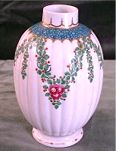 A very elegant
and rare First Period Worcester porcelain Tea Caddy. This delightful and most
charming Tea Caddy is of an oval vase shape standing on a circular base. The
body of this pretty Caddy is of vertical moulded form and has a raised circular
neck.
A very elegant
and rare First Period Worcester porcelain Tea Caddy. This delightful and most
charming Tea Caddy is of an oval vase shape standing on a circular base. The
body of this pretty Caddy is of vertical moulded form and has a raised circular
neck.
The body is beautifully decorated starting with an unusual turquoise blue scalloped band around the shoulder of the Caddy. There is an applied black circle decoration painted on top of this ground colour, giving a lovely effect.
There are swags and garlands of green foliage with red berries together with triple pink roses, very elegantly painted in rich enamels.
This is a charming and most exquisitely decorated First Period Worcester Tea Caddy, c1770. A rare item of Worcester porcelain and one for the collector of fine quality eighteenth century English porcelain.
More details of this item and other tea related antiques can be found by visiting my web site at www.TeaAntiques.com.
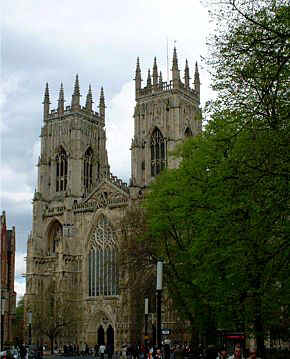
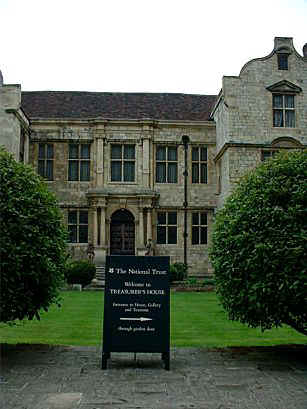 Tucked
behind the great York Minster, is a very old house called the Treasurer's House,
which as the name suggests was the home to the treasurer. The house is now
administered and open to the public by the National Trust.
Tucked
behind the great York Minster, is a very old house called the Treasurer's House,
which as the name suggests was the home to the treasurer. The house is now
administered and open to the public by the National Trust.
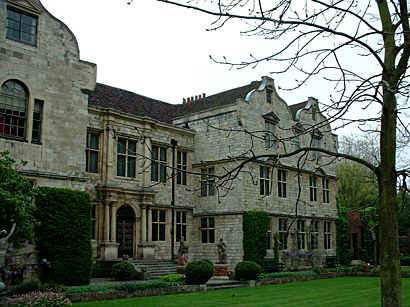 There
is a long history to this house, the earliest parts of which date from the
sixteenth century. It was built on a scheme of a central hall with a section on
either side-one for services the other for private living. The house has since
undergone many changes. In the seventeenth century the central block was
increased in size by widening it. Looking at the front elevation there is a
symmetry about it, this being the Renaissance influence. However, it is not
actually symmetrical, upon close inspection of the garden front, it can be seen
that not only are some windows different in size, but there is a difference in
the floor levels at different ends of the building. The answer to this, is that
the façade was superimposed on an earlier structure. The two Dutch gables at
either end do pull the symmetry together.
There
is a long history to this house, the earliest parts of which date from the
sixteenth century. It was built on a scheme of a central hall with a section on
either side-one for services the other for private living. The house has since
undergone many changes. In the seventeenth century the central block was
increased in size by widening it. Looking at the front elevation there is a
symmetry about it, this being the Renaissance influence. However, it is not
actually symmetrical, upon close inspection of the garden front, it can be seen
that not only are some windows different in size, but there is a difference in
the floor levels at different ends of the building. The answer to this, is that
the façade was superimposed on an earlier structure. The two Dutch gables at
either end do pull the symmetry together.
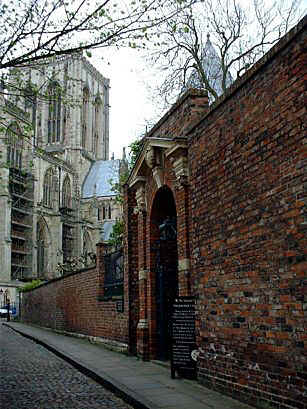 During
its history, King James I was entertained in the house by the Archbishop's son,
Sir George Young. The house has had many owners including a great
Parliamentarian leader, Thomas Fairfax. He was one of the first owners after the
Young's sold the house in 1649. Thomas Fairfax may have been responsible for the
addition of a Long Gallery at the back of the house.
During
its history, King James I was entertained in the house by the Archbishop's son,
Sir George Young. The house has had many owners including a great
Parliamentarian leader, Thomas Fairfax. He was one of the first owners after the
Young's sold the house in 1649. Thomas Fairfax may have been responsible for the
addition of a Long Gallery at the back of the house.
In the eighteenth century, the Treasurer's house went through various owners including gentry families, clerics and lawyers. Such owners were wealthy enough to use this house as their town house for use during the winter months, the summer being spent in their large country homes. During the Georgian period there were some more changes to the house, but the basic structure was retained.
In the late Georgian period the house was divided up to smaller residences, changes to windows and fine plaster ceilings were installed. However, by the end of the nineteenth century the house had sadly started to decay and was now divided into at least five separate dwellings.
In 1897 one of these integral properties within the house was auctioned off. It was bought by Frank Green. In just six months, he had managed to buy another three portions of the house. Finally, by 1900 he together with Edward Gray had created just two properties form the entire house, these became the Treasurer's house that we see today and Gray's Court.
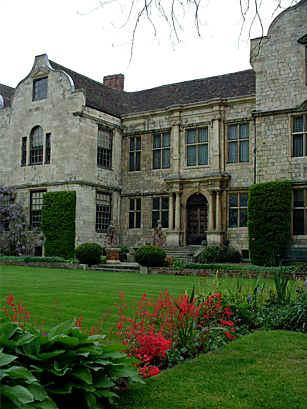 Inside
the house we see rather a mixture of styles, mostly rather dark panelled or
certainly drab painted rooms. In the centre of the house is the Great Hall
rising up to the roof, thus dividing the sections of the house either side.
Consequently, the two side portions of the house have their own staircases. Much
of the furniture in the house dates from the seventeenth century, heavy in
appearance.
Inside
the house we see rather a mixture of styles, mostly rather dark panelled or
certainly drab painted rooms. In the centre of the house is the Great Hall
rising up to the roof, thus dividing the sections of the house either side.
Consequently, the two side portions of the house have their own staircases. Much
of the furniture in the house dates from the seventeenth century, heavy in
appearance.
There is a large Drawing Room, which before 1897 had been two rooms. There are a pair of very fine early gilt wood framed mirrors either side of the fireplace, below which are a pair of gilt and marble topped pier tables. The room is painted a very dark and drab rich blue making the room feel rather dreary. Even the gilt wood framed suite of furniture fail to lift the room's appearance.
There is a room which will be of interest to the lover of tea antiques. This room is the Dining Room - although there is no dining table or chairs in there, there are two display cabinets at either end of the room. In one of them, there is a collection of very early china teapots. These teapots are generally rather 'brown' or dull in their appearance, but are rare and very early examples. One of the more unusual was a set of items moulded in the form of Cauliflowers - very realistic they are too. These 'Cauliflower' shaped pots were made in Staffordshire, c 1760. The teapot of this set has a curved spout with leaves around its base and has a foliate scrolled handle. The body of these pots were of earthenware, the florets of the Cauliflower in a deep cream the surrounding leaves of a green stained glaze. The detail in the moulding of these pots is superb. Also on display is a coffee pot, covered milk jug, covered sugar bowl and a square shaped tea caddy.
There are colourful teapots including earthenware ones marbled with light and dark brown and blue slips, made in Staffordshire, c1740.
An unusual teapot was one of a six lobed shape, the spout and handle moulded with overlapping foliage, the lid knob moulded in the shape of a Lamb. The body of this delightful teapot had relief mouldings on each side, with rococo scrolls which enclosed a charming pastoral scene. This scene shows a three story house with sheep grazing around it- absolutely delightful. This beautiful teapot was the creation of Wedgwood, Burslem, c1765.
Of local interest is a set including an oval teapot, tea bowls and saucers in Pearlware, decorated with bands of marbled brown and blue slips. There are moulded gilt swags, the lid having a moulded acorn knob, the set was possibly made nearby in Castleford or Leeds, c1800.
 The
cabinet at the other end of the room contains a comprehensive tea service of
Worcester porcelain. The design is the famous 'wheel' or 'whirl' or more widely
known as 'Queen Charlotte' pattern, c1760-70. (The picture here is taken from
the Victoria Art Gallery in Bath and shows two covered vases of the same
pattern.)
The
cabinet at the other end of the room contains a comprehensive tea service of
Worcester porcelain. The design is the famous 'wheel' or 'whirl' or more widely
known as 'Queen Charlotte' pattern, c1760-70. (The picture here is taken from
the Victoria Art Gallery in Bath and shows two covered vases of the same
pattern.)
The Tea wares on display are of an early period and are quite a rare collection to see. The Treasurer's House is certainly worth a visit for anybody who finds themselves in the wonderful and historic city of York.
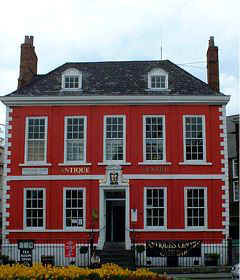 Not far from
the Minster and centre of York - The Ginnel Antique Centre houses cabinets of
various antiques - silver, porcelain, etc. of many periods.
Not far from
the Minster and centre of York - The Ginnel Antique Centre houses cabinets of
various antiques - silver, porcelain, etc. of many periods.
The tea room in the Ginnel Antique Centre provides a wonderful and peaceful retreat from the crowded streets of York. The tea room is set in an upper floor of this early Georgian house, with crimson walls and very pleasant music playing the day I was there. This is an ideal place to sit and ponder the antiques for sale in the Centre. Here magazines, such as "Masterpiece", are provided for customers to browse whilst enjoying the pleasures of tea.
The tea room serves tea in China tea pots and fresh flowers decorate each of the glass topped tables bedecked with yellow linen. It is obvious from the quality, the cakes are home-made and looked absolutely delicious - especially the walnut and coffee sponge which had a wonderfully raised top so I can imagine that it had a very light texture.
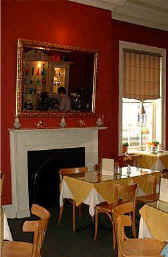
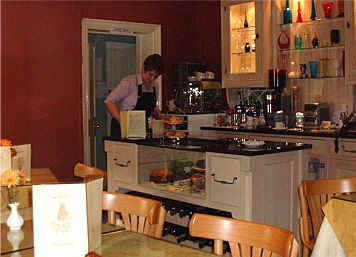
Here I found the scones to be very good indeed - freshly baked with sultanas and having a beautiful crispness to the top - one of the most delicious I have tasted. They were served with a dish of warm butter - so easy to spread - and a small pot of jam. Also offered is the classic fruit cake with Wensleydale Cheese.
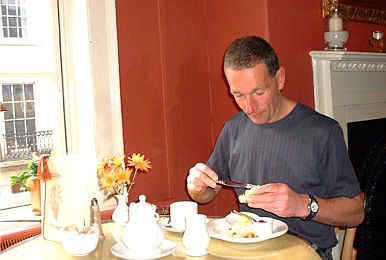
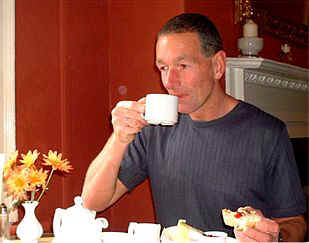
The tea room in the Ginnel Antique Centre certainly provide a most pleasant place in which to indulge in a relaxing afternoon tea, whilst also offering the chance to do a little antique shopping.
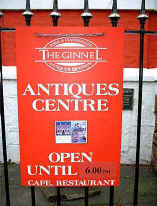 The Ginnel
Antique Centre
The Ginnel
Antique Centre
1 Duncombe Place, York
Open Monday to Saturday 10-5
Street map
Map courtesy of www.streetmap.co.uk.
To review past newsletters, just follow this link:
Past newsletters.
To subscribe to this free newsletter -
Click here